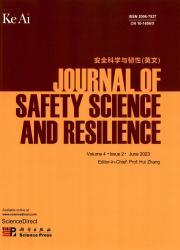把握紧急情况动态:重大突发事件中的集体疏散技术和策略综述
IF 3.4
Q1 PUBLIC, ENVIRONMENTAL & OCCUPATIONAL HEALTH
引用次数: 0
摘要
洪水、地震和火灾等重大突发灾害往往会造成重大人员伤亡。紧急疏散对于减轻这些影响至关重要。不同类型的灾害事件在影响范围、突发性和紧迫性方面存在很大差异。每种类型的灾害都具有不同的特点,因此对紧急疏散的要求也不尽相同。因此,我们通过 VOSviewer 和 ArcGIS 对科学网数据库中的 7213 篇出版物进行了分析,对 2004-2023 年重大自然灾害中的疏散过程进行了文献计量分析和可视化绘图。我们的研究确定了三个发展阶段:初始阶段(2011 年前),共发表 1169 篇论文;增长阶段(2012-2018 年),共发表 2772 篇论文;扩展阶段(2019 年后),共发表 3335 篇论文。本研究对重大灾难情景下的紧急疏散理论和方法进行了全面回顾和分类。它强调了评估不同类型重大突发灾害的范围和强度、定义和模拟受影响人群的受影响行为以及制定相应的差异化紧急疏散策略的必要性。关键词分析揭示了支持这些发现的两大趋势:一是越来越重视复杂的疏散建模和仿真技术,表现为应用各种仿真优化的微观和宏观模型,如蜂窝自动机、社会力模型、基于代理的模型、人流和网络流模型等,增强对灾害的理解和预测能力;二是针对特定灾害背景制定有针对性的疏散策略,从而提高灾害响应效率。报告概述了未来安全疏散研究的三条主要途径:改进疏散行为模型以提高准确性、改善复杂的多层次疏散程序的协调性以及更完美地整合室内外疏散策略。它为推进重大紧急情况下的安全疏散研究建立了一个前瞻性框架。本文章由计算机程序翻译,如有差异,请以英文原文为准。
Grasping emergency dynamics: A review of group evacuation techniques and strategies in major emergencies
Major sudden disasters, such as floods, earthquakes, and fires, often cause significant casualties. Emergency evacuation is crucial in mitigating these impacts. Different types of disaster incidents vary significantly in terms of impact scope, suddenness, and urgency. Each type of disaster possesses distinct characteristics, necessitating varying requirements for emergency evacuation. Consequently, we conducted a bibliometric analysis and visual mapping of evacuation processes in major natural disasters from 2004-2023, analyzing 7213 publications from the Web of Science database via VOSviewer and ArcGIS. Our study identified three developmental phases: an initial phase (pre-2011) with 1169 publications, a growth phase (2012-2018) with 2772 publications, and an expansion phase (post-2019) with 3335 publications. This study provides a comprehensive review and classification of emergency evacuation theories and methods in major disaster scenarios. It emphasizes the necessity of assessing the scope and intensity of different types of major emergent disasters, defining and simulating the affected behaviors of the influenced populations, and formulating differentiated emergency evacuation strategies accordingly. Keyword analysis reveals two main trends supporting these findings: an increasing focus on complex evacuation modeling and simulation techniques, manifested in the application of various simulation-optimized microscopic and macroscopic models such as cellular automata, social force models, agent-based models, pedestrian flow, and network flow models, enhancing disaster understanding and prediction capabilities; and the strategic development of tailored evacuation strategies for specific disaster contexts, thereby improving disaster response efficiency. Three key future pathways for safety evacuation research are outlined: refining evacuation behavior models for greater accuracy, improving the coordination of complex, multi-level evacuation procedures, and integrating indoor and outdoor evacuation strategies more seamlessly. It establishes a forward-looking framework for advancing safety evacuation studies in major emergencies.
求助全文
通过发布文献求助,成功后即可免费获取论文全文。
去求助
来源期刊

安全科学与韧性(英文)
Management Science and Operations Research, Safety, Risk, Reliability and Quality, Safety Research
CiteScore
8.70
自引率
0.00%
发文量
0
审稿时长
72 days
 求助内容:
求助内容: 应助结果提醒方式:
应助结果提醒方式:


